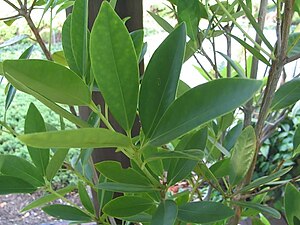Illicium verum/ja: Difference between revisions
Created page with "==参照== {{Commons|Illicium verum|position=left}}" |
Created page with "===仕様=== * ISO 11178:1995 – ドライフルーツの仕様" Tags: Mobile edit Mobile web edit |
||
| Line 115: | Line 115: | ||
</div> | </div> | ||
===仕様=== | |||
== | * [[Wikipedia:ISO|ISO]] 11178:1995 – ドライフルーツの仕様 | ||
* [[ISO]] 11178:1995 – | |||
==参照== | ==参照== | ||
Revision as of 21:21, 15 June 2025
| Illicium verum/ja | |
|---|---|

| |
| トウシキミ(Illicium verum) がアメリカ国立樹木園にあるる | |

| |
| 八角の果実と種子 | |
| Scientific classification | |
| Kingdom: | Plantae |
| Clade: | Tracheophytes |
| Clade: | Angiosperms |
| Order: | Austrobaileyales |
| Family: | Schisandraceae |
| Genus: | Illicium |
| Species: | verum
|
| Binomial name | |
| verum | |
| Synonyms | |
| |
Wikの翻訳 カスタム Gem トウシキミ(Illicium verum)(八角、スターアニス、チャイニーズスターアニス、スターアニスシード)は、中国南部およびベトナム北東部原産の中型の常緑樹である。熟す直前に収穫される星形をしたその果皮は、アニスに風味がよく似たスパイスである。主な生産国は中国で、ベトナムや他の東南アジア諸国がそれに続く。八角油は非常に香りが高く、料理、香水、石鹸、歯磨き粉、うがい薬、スキンクリームなどに使用される。2012年に遺伝子組み換え大腸菌を使用するようになるまで、ロシュ・ファルマシューティカルズはシキミ酸を介してオセルタミビル(タミフル)を製造するために、世界の年間八角収穫量の最大90%を使用していた。
Etymology and nomenclature
| Star anise | |||||||||||||||||||
|---|---|---|---|---|---|---|---|---|---|---|---|---|---|---|---|---|---|---|---|
| Chinese | 八角 | ||||||||||||||||||
| Literal meaning | "eight-horns" | ||||||||||||||||||
| |||||||||||||||||||
Illicium comes from the Latin illicio meaning "entice" or "seduce".
Verum means "true" or "genuine".
The name "badian" appears to derive, via French badiane, from the apparently descriptive Chinese name for it, 八角, pinyin: bājiǎo, lit. "eight horns". However, a derivation from the Persian بادیان bādiyān, "fennel", exists, with the Oxford English Dictionary indicating that its origin before that is unknown.
Description
Leaves are aromatic, simple and lanceolate, obovate-elliptic or elliptic, size of 5–15 cm × 2–5 cm, coriaceous to thickly coriaceous. The leaves are 5–15 cm × 1.5–5 cm, apex acute, lower side pubescent. Flowers are solitary, bisexual, pink to dark red, axillary or subterminal. The perianth has lobes 7–12, arranged spirally; stamens number of 11–20, arranged spirally, with short, thick filaments; carpels usually 8, free, arranged in a single whorl. Flower peduncle size is 1.5–4 cm, tepals number range from seven to twelve, and are broadly elliptic to broadly ovate, anthers size is 1–1.5 mm, pollen grains trisyncolpate.
The fruit is a capsule-like follicetum, star-shaped, reddish-brown, consisting of six to eight follicles arranged in a whorl. Each follicle is boat-shaped, 1–2 cm long, rough and rigid, color reddish-brown, with 1 seed, opening along the ventral edge when ripe. carpels size of 10 mm long, boat-shaped; they are hard and wrinkled, containing one seed. Seeds are brown, compressed ovoid, smooth, shiny and brittle with approximate size of 8–9 mm × 6 mm.
Differences with similar taxa: Illicium anisatum had smaller fruits that does not form a regular star due to the abortion of some carpels. Also fruit follicles are not swollen in the middle and had a more pointed apex. Also usually had more than 8 follicles and the fruit has weaker odour. The seeds in Illicium anisatum are flat or almost spherical.
Use
Culinary use


Star anise contains anethole, the same compound that gives anise, an unrelated plant, its flavor. Star anise has come into use in the West as a less expensive substitute for anise in baking, as well as in liquor production, most distinctively in the production of the liqueur Galliano.Star anise enhances the flavor of meat.
It is used as a spice in preparation of biryani and masala chai in some parts of the Indian subcontinent. It is widely used in Chinese cuisine, and in Malay and Indonesian cuisines. It is widely grown for commercial use in China, India, and most other countries in Asia. Star anise is an ingredient of the traditional five-spice powder of Chinese cooking. It is also a major ingredient in the making of phở, a Vietnamese noodle soup.
It is also used in the French recipe of mulled wine, vin chaud (hot wine). If allowed to steep in coffee, it deepens and enriches the flavor. The pods can be used in this manner multiple times by the potful or cup, as the ease of extraction of the taste components increases with the permeation of hot water.
Drug precursor
Star anise is the major source of the chemical compound shikimic acid, a primary precursor in the pharmaceutical synthesis of the anti-influenza drug oseltamivir (Tamiflu). An industrial method for the production of shikimic acid using fermentation of E. coli bacteria was discovered in 2005, and applied in the 2009 swine flu pandemic to address Tamiflu shortages, eventually reversing price increases for star anise as a raw material of shikimic acid. As of 2018, fermentation of E. coli was the manufacturing process of choice to produce shikimic acid for synthesis of Tamiflu.
Illicium verum is not toxic. However, other related species are toxic.
Japanese star anise (Illicium anisatum), a similar tree, is highly toxic and inedible; in Japan, it has instead been burned as incense. Cases of illness, including "serious neurological effects, such as seizures", reported after using star anise tea may be a result of deliberate economically motivated adulteration with this species. Japanese star anise contains the neurotoxin anisatin, which also causes severe inflammation of the kidneys (nephritis), urinary tract, and digestive organs when ingested.
Swamp star anise Illicium parviflorum, a similar tree found in the southern United States, is highly toxic and should not be used for folk remedies or as a cooking ingredient.
ISO Standardization
- ISO 676:1995 – contains the information about the nomenclature of the variety and cultivars
Identification
- Refer to the 4th edition of the European Pharmacopoeia (1153)
Differentiation from other species
Joshi et al. have used fluorescent microscopy and gas chromatography to distinguish the species, while Lederer et al. employed thin layer chromatography with HPLC-MS/MS.
仕様
- ISO 11178:1995 – ドライフルーツの仕様
参照
| この記事は、クリエイティブ・コモンズ・表示・継承ライセンス3.0のもとで公表されたウィキペディアの項目Illicium verum(24 May 2025, at 09:49編集記事参照)を翻訳して二次利用しています。 |